Overview
The multi-talented Quantum X shape is truly competent. Based on Two-Photon Polymerization (2PP), the 3D laser lithography system combines proprietary 3D printing technologies, making it the best tool for rapid prototyping and wafer-scale batch processing of practically any 2.5D and 3D shape with submicron precision and accuracy.
In addition to Nanoscribe’s ground-breaking Two-Photon Grayscale Lithography (2GL®) for surface patterning technology, Quantum X shape, the second high-resolution two-photon lithography system in the industry-proven Quantum X platform, provides high-resolution 3D Microfabrication capabilities with unmatched precision.
Video Credit: Nanoscribe
The highest voxel modulation rate in its class and an extremely fine address grid, which permits sub-voxel size shape control, are the foundations of the new Quantum X shape’s superior precision. The 2GL voxel tuning capability for 2.5D structures with stunningly smooth, precisely shaped, or micropatterned surfaces is also advantageous to the users.
Quantum X shape is the optimum additive manufacturing tool for quick prototyping of application designs in a variety of fields, including surface engineering, microfluidics, microelectromechanical systems (MEMS), microoptics, and biomedical devices.
Wafer-scale batch processing and small-series production of 3D microparts are now easier than ever, thanks to the wafer handling capabilities.
Utilize the touchscreen integrated into the device to manage the print job. Use nanoConnectX to monitor the two-photon lithography system in multi-user configurations and even from the office, benefit from batch wafer production that is quick and to industry standards.
Features
- Prototyping from nano to meso
- Nano to mesoscale prototype development the class’s most sophisticated 3D printer. Print any design with features as small as 100 nm and areas as large as 25 cm2
- Wafer-scale batch processing
- Overnight, upright system for more than 200 typical structures with automatic dispensing on wafers
- Open printing material system
- High-performance 2PP materials that can be used for polymer and glass printing are available
- Industry-proven platform for wafer-scale batch processing
- Open direct laser writing system for custom-made and third-party materials
- Rapid prototyping with peak precision and design freedom along a straightforward workflow
- Wide range of application-specific and universal printing materials
- Print volumes up to 30 cubic centimeters in one pass with the new XLF Print Set
- 200 typical mesoscale structures printable overnight
- High-speed 3D Microfabrication with ultra-fast voxel modulation rate and 100 nm address grid
- Automated self-calibration routines for accurate laser power control and positioning
- Advanced galvo trajectory control enables highest accuracy at maximum scan speed
- Interface finder for transparent, opaque, and reflective surfaces with nanoprecision
- Broad range of substrates and wafers up to 6”
- Industrial batch processing: 200 typical mesoscale structures printable overnight
- Touchscreen and remote control ensure high usability
Application areas
- Nanoscale printing-feature size control in all spatial directions down to 100 nanometers
- Macroscale printing-XLF Print Set speeds up batch production of voluminous centimeter-sized objects up to 50 × 50 × 12 mm³
- Microscale printing—with typical dimensions from 50 to 700 μm
- 2GL Grayscale Lithography for stunningly rapid and accurate surface patterning
- 2PP-based high-resolution 3D printing
- Mesoscale printing-with dimensions up to several millimeters
XLF Print set
For high-precision macroscale printing
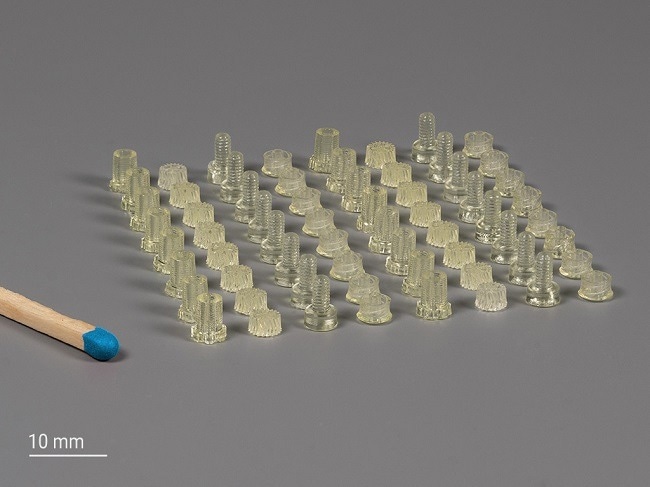
With the new XLF Print Set you can produce many millimeter-sized parts with complex structures and finest details in one pass. Image Credit: Nanoscribe
- The production of microscale objects is the main goal of two-photon polymerization 3D printing. This manufacturing range now includes millimeter- and centimeter-sized objects with the highest degree of precision and shape accuracy, in addition to nano- and microscale structures
- Users who use the new XLF Print Set gain access to wafer-scale batch production with print volumes of up to 30 cubic centimeters in a single pass
- With the XLF Print Set’s 5× air objective lens, the print field diameter can be increased to up to 3,200 µm, and the working distance is comparatively large at 18.5 mm.
- The XLF Print Set’s extremely fast scanning speeds make it perfect for a variety of applications, including the prototyping of mechanical and microfluidic parts and structures, housings, connectors, and nozzles
- Two-photon polymerization-based 3D microfabrication for research labs and multi-user facilities with the highest output and quality standards in the fields of:
- Life sciences
- Material engineering
- Microfluidics
- Micromechanics & MEMS
- Refractive microoptics
- Diffractive microoptics
- Integrated photonics
- Designed to assist the best researchers and manufacturers in the world realize the full potential of high-resolution microfabrication and additive manufacturing with:
- Rapid prototyping by two-photon lithography
- Batch processing / small series production
- Wafer-scale fabrication
Incredible range of microfabrication of opportunities
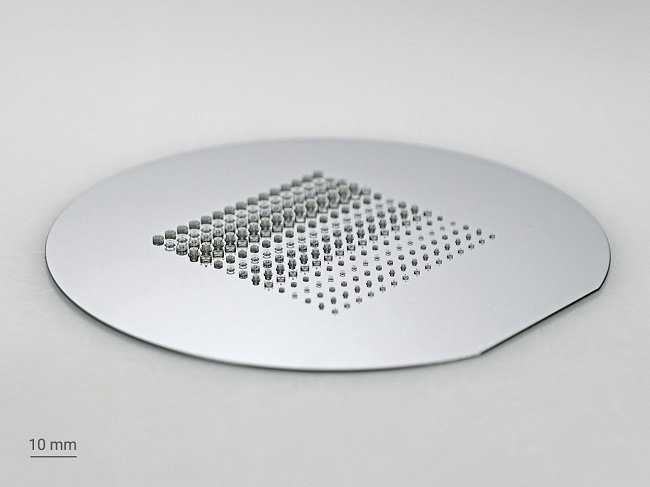
Array of micromechanical structures. Quantum X shape can address an area of 50 x 50 mm² on substrates such as wafers and microscope slides made of silicon, glass, and other transparent or opaque materials. Image Credit: Nanoscribe
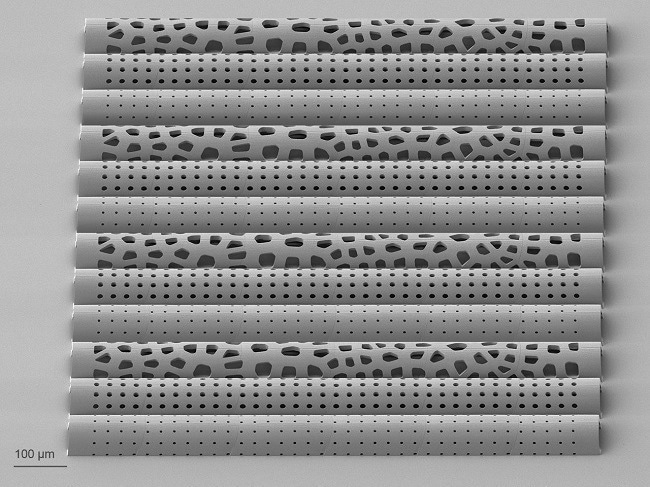
Tunnel-shaped filter membranes with three different pore sizes and geometries. Quantum X shape offers true design freedom on the microscale for every application. Image Credit: Nanoscribe
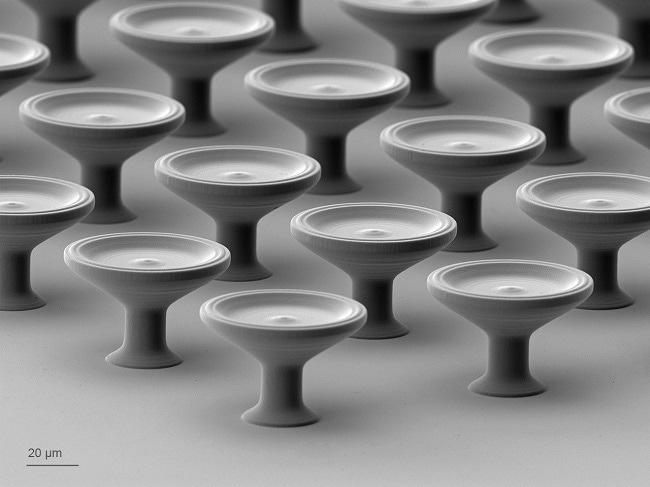
Array of funnel-shaped adhesive microstructures. Microstructured surfaces are the key to reversible surface adhesion and can be easily fabricated via high-precision 3D printing by Two-Photon Polymerization and wafer-scale batch processing with Quantum X shape. Image Credit: Nanoscribe
Specifications
Benchmark scores
Table 1. Source: Nanoscribe
| . |
. |
| Surface roughness (Ra) |
down to ≤ 5 nm |
| Feature size control 1 |
down to 100 nm |
| Shape accuracy |
down to ≤ 200 nm |
| Batch processing |
up to 200 typical mesoscale structures overnight |
| Autofocus precision |
down to ≤ 30 nm |
| Single print field diameter |
up to ≥ 4,000 µm |
| Maximum scan speed |
6.25 m/s divided by lens magnification2 |
General system properties
Table 2. Source: Nanoscribe
| test |
Time |
| Printing technology |
Layer-by-layer 3D printing based on Two-Photon Polymerization (2PP)
Two-Photon Grayscale Lithography (2GL®) with voxel tuning capability |
| Substrates |
Microscope slides (3 x 1” / 76 x 26 mm)
Wafers from 1” to 6” (25.4 mm to 150 mm)
Glass, silicon, and further transparent and opaque materials |
| Photoresins |
Nanoscribe IP Photoresins (polymer printing)
Nanoscribe GP-Silica (glass printing)
Open for third-party and custom materials |
| Maximum print area |
50 x 50 mm² |
Given values may vary depending on the photoresin and structure geometry.
1 100 nm feature size control in all spatial directions
2 e.g. for 10x magnification: 625 mm/s
With Quantum X shape customers benefit from the fastest and most accurate tool for 3D printing with highest-precision and unparalleled batch processing capability.”
Dr Michael Thiel, Chief Science Officer (CSO) and Co-Founder, Nanoscribe
Services
Field-proven software for 3D Microfabrication at wafer level
- How to get the final 3D-printed structure from the 3D design? Users will achieve their successful print with the help of Nanoscribe’s software solutions. Create, upload, print, and keep an eye on the print job remotely from the PC or directly from the touchscreen of the device
Video Credit: Nanoscribe
- Generate the 3D print job with DeScribeX: The 3D print job development software walks the user through the process of importing a 3D CAD model, uploading the print job, and more in just a few simple steps. It is based on the field-tested 2PP software DeScribe
- Generate the 2.5D print job with GrayScribeX: The proprietary.nano file for each user’s unique project is created and uploaded to the Quantum X system in just a few simple steps using the print job development software
- Start the print job via the touchscreen: Quantum X’s user-friendly touchscreen menu guides them to successful printing with ease. Profit from crucial information like hardware details, system status, and print progress. Additionally, users can always control the print process visually thanks to a live view provided by three cameras
- Stay connected with nanoConnectX: With the remote access software nanoConnectX, users can start and monitor their print jobs from the office. As a result, the Quantum X system is well suited for additive manufacturing production settings and multi-user scenarios
Software facts
DeScribeX
- DeScribeX is a print job development tool for QuantumX shape that enables the creation of customized 3D print jobs. As a popular 3D CAD format, STL files can be loaded using the integrated import wizard
- The pre-installed software printing parameter presets are the ideal places to start because they will lead users through each step of the printing process. The print job can be remotely transferred to the Quantum X shape using the export function
Table 3. Source: Nanoscribe
| Key feature |
Benefits |
| 3D CAD model import wizard |
Intuitive workflow generates suitable print job files from standard STL files |
| Print parameter presets |
Ready-to-use preset parameters to achieve optimal high-precision 3D printing results right out of the box |
| Adaptive slicing |
For surface refinement and improved submicrometer shape accuracy |
| Parameter sweep |
For easily finding perfectly matching print parameters for new materials and applications |
| Integrated Development Environment (IDE) |
Experts can generate and modify print files (GWL) for customized and sophisticated printing tasks |
| 3D preview and printing simulation |
What you see is what you print! DeScribeX displays parameters such as print time, scan speed or laser power and simulates the whole printing process in detail |
| .nano files |
Take advantage of the container file format that includes all necessary information for data exchange and a successful print in a single file |
GrayScribeX
- A specially designed piece of software called GrayScribeX is used to create customized 2D and 2.5D print jobs for Quantum X microfabrication systems. Users can import pre-made grayscale images or CAD models that have already been converted to grayscale
- The heights of the print object are determined precisely by a clever software routine that converts the grey values from the imported design into those heights
Table 4. Source: Nanoscribe
| Key feature |
Benefits |
| Import of 16 bit grayscale images and CAD files |
Use standard image files .bmp and .png as well as the CAD format .stl |
| Remote upload of print jobs |
Work and connect remotely with Quantum X shape from the office |
| Add, remove and duplicate structures to the print job |
Create print jobs of different structures in one file |
| Rescale your structures and create arrays |
Modify the structures to meet individual requirements for the corresponding application |
| Field-proven print parameter presets |
Benefit from ready-to-use preset parameters for straightforward printing of any grayscale design |
| Internal calibration files |
Easily translate your gray values into the corresponding writing parameter |
| .nano files |
Take advantage of the container file format that includes all necessary information for data exchange and a successful print in a single file |
Touchscreen
- Utilize the Quantum X shape front panel touch screen and the graphical user interface to control and monitor the 2PP system (GUI). In just a few steps, it directs users to a successful print. After choosing the print project, load the substrate, and then begin printing
Table 5. Source: Nanoscribe
| Key feature |
Benefits |
| Three live cameras |
Monitor the direct laser writing process online from three perspectives and always be up to date on the current status of your print job |
| Stage control in x, y and z direction |
Move the stage to any position on the substrate to define your print area |
| User-friendly print setup |
Select resin and substrate, and start the print job with just one click |
| Project list |
Keep track of the entire print job history |
| Automatic interface finder |
Identify the interface of the substrate with submicrometer accuracy |
nanoConnectX
- Quantum X systems use nanoConnectX as their remote access software. Any computer that is connected to the internet now has access to all the touchscreen’s features and display capabilities
Table 6. Source: Nanoscribe
| Key feature |
Benefits |
| Remote access to the system |
Connect Quantum X shape to your computer, no matter where you are |
| Use all features of the touchscreen |
Prepare, control and monitor your print jobs from any location |
| Upload and download print jobs and reports |
Take advantage of a direct access from your computer to print-related files |
How to reshape microfabrication
- Any 2.5D and 3D microfabrication task can benefit from Quantum X shape’s true design freedom. High aspect ratio structures, vertical walls, undercuts, and other difficult features can all be printed using the new high-resolution 3D printing system
- The perfect high-precision microfabrication tool for use in the life sciences, material engineering, micromechanics, and other microtechnology fields is Quantum X shape
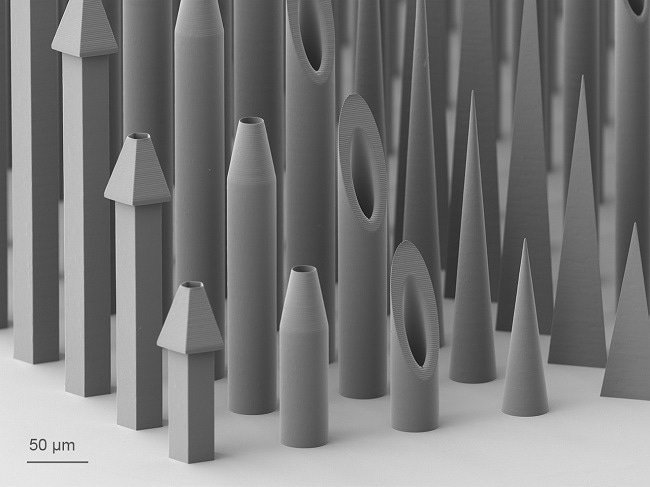
The 3D-printed microneedles in this image demonstrate the capabilities of Nanoscribe’s microfabrication technology to realize high aspect ratio, hollow and sharp tip applications with unmatched precision. Image Credit: Nanoscribe
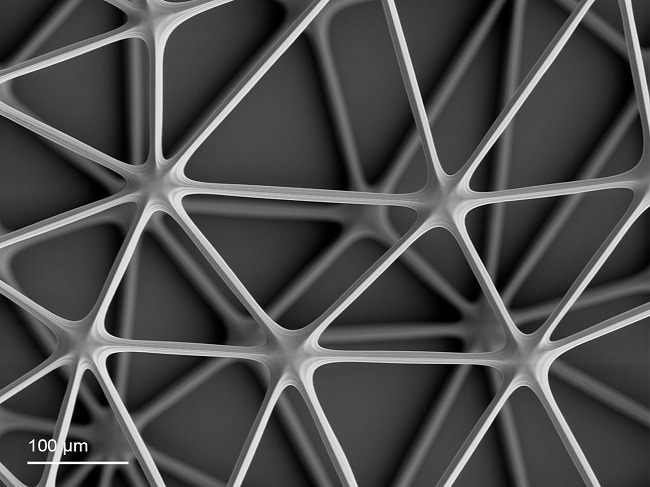
Top view of a 3D mesh cube with filigree micrometer-sized connecting struts and freestanding undercuts that can only be fabricated using the additive approach of Two-Photon Polymerization (2PP). Image Credit: Nanoscribe
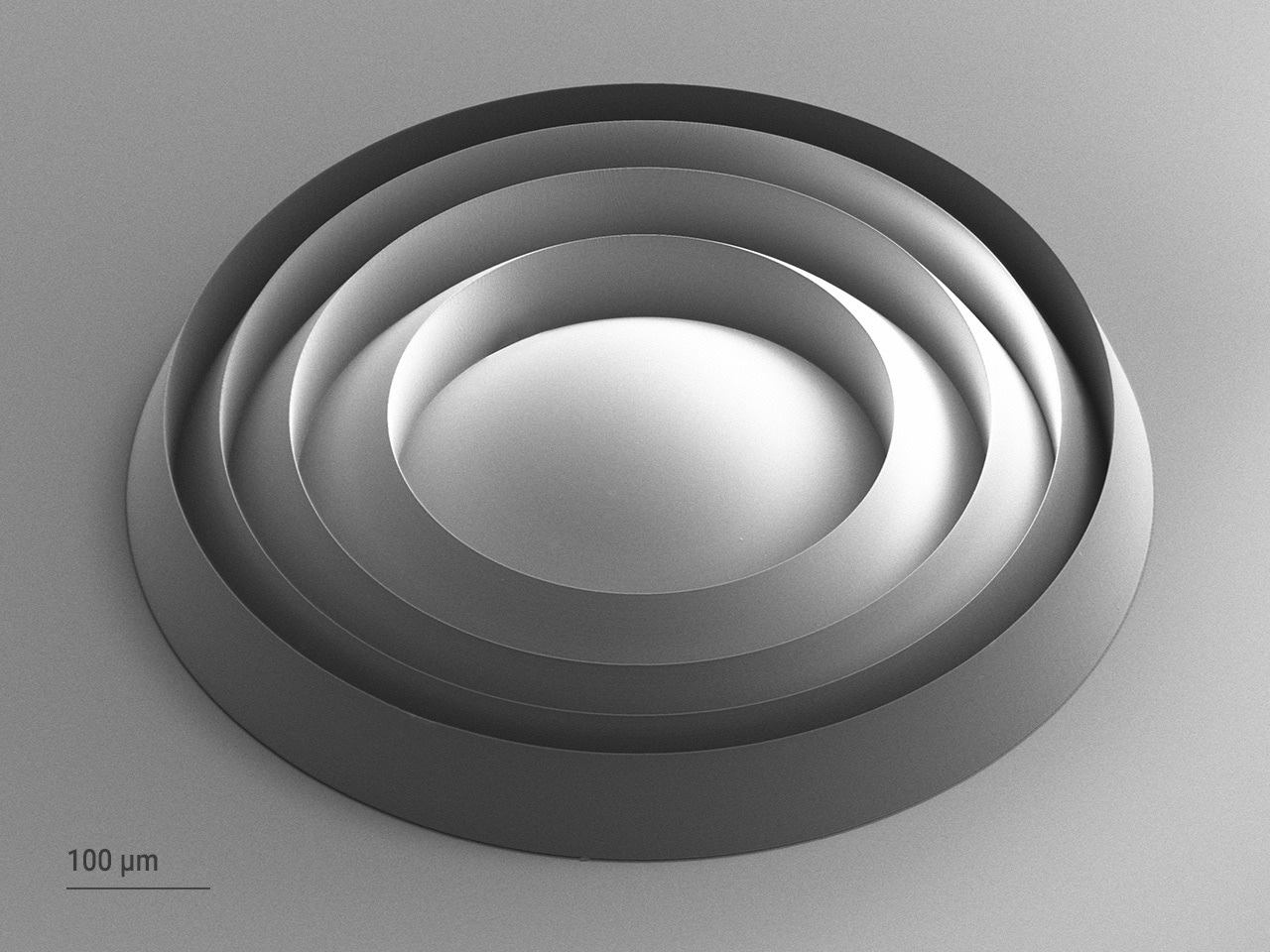
Fresnel lenses enable high optical quality even for planar optics. Quantum X shape’s integrated Two-Photon Grayscale Lithography (2GL®) and its underlying voxel tuning technology enables the fabrication of 2.5D microstructures with submicron shape accuracy and surface roughness of less than 5 nm (Ra). Image Credit: Nanoscribe